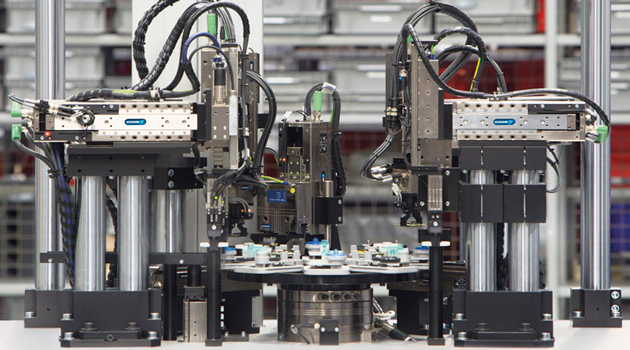Power to Mechatronics: 24V Assembly Systems
Assembly systems must be set up flexibly today. The 24V smart technology makes it possible to take a step forward in this direction acting as an alternative option to traditional pneumatic networks. SCHUNK decided then to face such a transformation actively: for the first time, complete handling systems can be assembled based on 24V from grippers, rotary gripping units and linear modules.
di Sergio Soriano
Besides the previously dominating pneumatic networks via which the currently around 70% of all actuators are supplied, and the grids >400V, which are currently circulated for electrically driven actuators and make up around 30%, the 24V technology is on the start line in order to become one of the third largest pillars in the field of assembly automation. According to the estimation of integrators, systems manufacturers and larger users, it has a wide range of advantages over pneumatics based on modern aspects: a rapidly growing range of varieties in many areas, increasingly sensitive parts, a very hard-fought price war and increasing requirements for energy efficiency and noise emissions play right into the hands of smart technology.
Keyword: flexibility
Assembly systems must be set up flexibly today. Pneumatic handling quickly reaches its limits faced with such requirements, particularly if the systems are to also work as noiselessly as possible and technical specifications can since retrieve maximum sound levels close to 60 dB. Despite the partially enormous progress for pneumatic networks and components, such as valve islands with intelligent pneumatics, micro valves that can be integrated into actuators or moderate purchase prices, this will not fully compensate for the strengths of 24V technology in the long term, meaning a redistribution of the market away from pneumatics right up to 24V technology is foreseeable.
SCHUNK has therefore consciously devoted itself besides the components that have proven themselves for years, such as the MGP-plus small components gripper, to modern 24V modules like the SCHUNK EGP, in order to proactively face the transformation. With the 24V SCHUNK PGN-plus-E universal gripper, the 24V counterpart to the megaseller, the PGN-plus-P, it was even possible to achieve complete maintenance freedom.
Highly dynamic and nevertheless protective
Taking the example of the SCHUNK ELP linear axis, it becomes clear how great the advantage over the pneumatic world is: even if users have to invest around double as much as for pneumatic axes, the wear-free module pays for itself in the medium and long term. For 40 million cycles total output and a maintenance interval of 5 million cycles, for pneumatic axes the costs for wear parts, working time and production downtimes alone add up to a value that far exceeds the total costs of the ELP axes. For an assembly system with 17 linear modules, in a life cycle of 40 million cycles, this results in a saving of around €12,000 not including the saving for the ongoing operating costs like compressed air.
Added to this come design benefits: often enough, throttles are opened far for pneumatic modules in practice, in order to save cycle time and to get the last reserves out of systems. As a consequence, the wear on the shock absorbers increases rapidly, and so too do the costs. Bigger companies are meanwhile planning fixed maintenance intervals in which all shock absorbers are replaced and re-calibrated regardless of their individual condition. This is a way of counteracting unplanned system downtimes. Nevertheless there are still unpleasant side effects in some areas: again and again the massive vibrations in the periphery of pneumatic linear modules also cause other components for instance camera systems to suffer too.
The collateral damage in some areas is partly substantial. This is precisely where the SCHUNK ELP comes in: it allows dynamic movements and nevertheless runs harmoniously and in so doing protects the peripherals in the end positions.
The outlook for 24V program setup
Even if the selection of handling components with 24V technology is still quite limited, the potential the technology has to offer can be imagined. Systems manufacturers and big users are meanwhile signalling great interest in a fast expansion of the 24V program and use the modules like the ELP linear axis or the EGP parallel gripper specifically to reduce vibrations, as actuators or as assembly systems in small systems and robot cells without compressed air supply.
At the latest when the companies active in handling technology provide components on 24V basis in the most important sizes from feeding technology right up to robots and safety technology that can be implemented on the move, the topic will continue to rapidly gain in importance.

